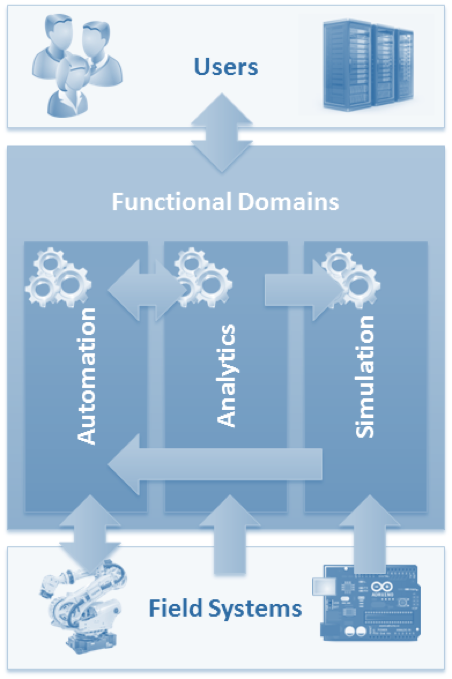According to the FAR-EDGE RA, the functionality of a factory automation platform can be decomposed into three high-level Functional Domains – Automation, Analytics and Simulation – and four Crosscutting (XC) Functions – Management, Security, Digital Models and Field Abstraction & Data Routing.
Functional Domains and XC Functions are orthogonal to structural Tiers. The implementation of a given functionality may – but is not required to – span multiple Tiers. The relationship between Functional Domains, their users and the factory environment is highlighted by arrows showing the flow of data and of control (unidirectional vs bidirectional).

Automation Domain
The FAR-EDGE Automation domain includes functionalities supporting automated control and automated configuration of physical production processes. Automated configuration is the enabler of plug-and-play factory equipment (better known as plug-and-produce), which in turn is a key technology for mass-customization, as it allows faster and less expensive adjustments of the production process to cope with a very dynamic market demand.
The Automation domain requires a bidirectional monitoring/control communication channel with the Field, typically with low bandwidth but very strict timing requirements (tight control loop). The Automation domain partially maps to the Control domain of the IIRA.
Analytics Domain
The Analytics domain includes functionalities for gathering and processing Field data for a better understanding of production processes – i.e., a factory-focused business intelligence. This typically requires a high-bandwidth Field communication channel, yet, channel latency tends to be less critical.
The Analytics domain provides intelligence to its users, but these are not necessarily limited to humans or vertical applications (e.g., a predictive maintenance solution): the Automation and Simulation domains, if properly configured, can both make direct use of the outcome of data analysis algorithms. In the case of Automation, the behaviour of a workflow might change in response to changes detected in the controlled process – e.g., a process drift caused by the progressive wear of machinery or by the quality of assembly components being lower than usual. In the case of Simulation, data analysis can be used to update the parameters of a digital model.
The Analytics domain matches perfectly the Information domain of the IIRA.
Simulation Domain
The FAR-EDGE Simulation domain includes functionalities for simulating the behaviour of physical production processes for the purpose of optimization or of testing what/if scenarios at minimal cost and risk and without any impact of regular shop activities. Simulation requires digital models of plants and processes to be in-sync with the real world objects they represent. As the real world is subject to change, models should reflect those changes. For instance, the model of a machine assumes a given value of electric power/energy consumption, but the actual values will diverge as the real machine wears down. To detect this gap and correct the model accordingly, raw data from the Field (direct) or complex analysis algorithms (from Analytics) can be used. However, it is important to point out that model synchronization functionality is not part of the Simulation domain, which acts just as a consumer of the Digital Models XC Functions.
There is no mapping between the Simulation domain and any functional domain of the IIRA: in the latter, simulation support is not considered as an integral part of the infrastructure.

